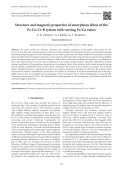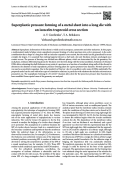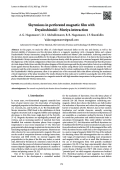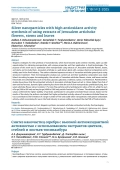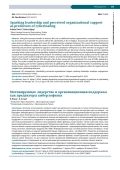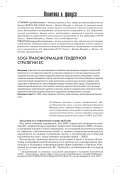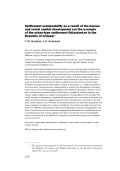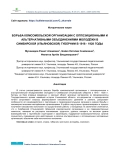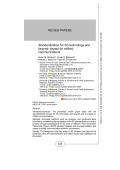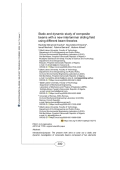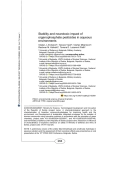The paper reveals the structure formation and magnetic properties of amorphous alloys based on the Fe-Co-Cr-B system with varying proportions of Fe to Co. These materials were obtained in the form of metal ribbons through the melt spinning technique in an inert atmosphere. In the initial as-spun state, the ribbons exhibited an amorphous structure characterized by their ferromagnetic properties. As the content of cobalt in the alloy composition decreased, the thermal stability of the amorphous phase matrix increased, leading to a shift in the crystallization mechanism from primary crystallization of the α solid solution phase to eutectic type crystallization of the initial amorphous phase. The phase composition of alloys during crystallization of the amorphous matrix phase is investigated. Alloys with a reduced cobalt content during the heating process undergo crystallization driven by the eutectic mechanism. This results in the formation of a mixture of α and Me3B phases. During this process, a significant increase in the magnetic moment of the alloys was detected. The α phase, which was formed by eutectic crystallization, was found to be enriched in chromium. It has been demonstrated that achieving a highly coercive state, it is contingent upon maintaining a Fe / Co ratio greater than 3, while simultaneously ensuring that the chromium content exceeds 16 at.%. The obtained data provides guidance for the development of functional materials with controlled magnetic properties.
Using the molecular dynamics method, a study of the compression deformation of nickel nanoparticles with amorphous and nanocrystalline structures at low temperatures was conducted. The influence of the size of nanoparticles on their strength and on the strain value at which maximum stress is reached has been investigated. The characteristics of deformation behavior in the case of amorphous and nanocrystalline nanoparticles were identified. It was shown that as the size of the nanoparticles decreased, both for amorphous and nanocrystalline types, their strength increased. The strength values for nanocrystalline nickel particles were approximately twice as high as those for particles with an amorphous structure. With decreasing particle size, the strain value at which maximum stress was reached during compression of the nanoparticles also increased. One possible reason for the influence of particle size on its strength in the case of an amorphous structure may be densification and partial crystallization of the structure near the load application sites. Partial crystallization in the contact patch regions during compression of amorphous nanoparticles was observed in the model in most cases. During compression of particles with a nanocrystalline structure, frequent phenomena included grain rotation and grain boundary sliding. As with amorphous nanoparticles, the phenomenon of structural densification near the contact patches and its reorientation were observed, such that the most densely packed atomic planes of the (111) type became parallel to the contact patch plane.
Superplastic deformation of thin sheets is widely used in aerospace, automotive and other industries. In this paper, a mathematical model of plane strain superplastic pressure forming of a sheet specimen into a die is proposed. A die under consideration has a shape of a long box with an isosceles trapezoid cross section, but the model can be generalized for more complex die shapes. It is assumed that sticking happens between a shell and a die and thickness remains unchanged once contact occurs. The process of forming was divided into different phases, which are determined by the die geometry. For each phase, ordinary differential equations for thickness were derived along with the initial conditions. Solutions of obtained ODEs allow estimating the shell thickness at any point of a specimen as a function of coordinate along walls of the die and to determine the duration of each superplastic pressure forming phase for a given pressure-time function. Norton’s power law was used as a constitutive equation. Due to the simplicity of Norton`s law it is possible to solve some of ODEs analytically. The proposed model can be used with other types of constitutive relations, in particular with relations that include microstructure parameters etc. The superplastic forming of a Ti-6Al-4V titanium alloy sheet for the piecewise pressure-time function has been modelled. Some special cases of die geometry are analyzed.
In this paper, we study the effect of a hole-shaped structural defect on the size and density, as well as the thermal stability of skyrmions and the skyrmion lattice in a magnetic monolayer with a triangular lattice and a planar Dzyaloshinskii−Moriya interaction, using the local relaxation method and Monte Carlo simulations. Achieving control over the skyrmion density opens possibilities for the design of functional skyrmion-based devices. It is shown that increasing the Dzyaloshinskii−Moriya parameter increases the skyrmion density, while the presence of an external magnetic field promotes the degeneracy of the mixed configuration of skyrmion-domains into the skyrmion lattice. We demonstrate that the presence of a hole-shaped defect does not affect the phase diagram of the skyrmion gas and the skyrmion lattice, but acts as a stabilizing factor against thermal fluctuations. The thermal stability was studies using Monte Carlo simulations to calculate the order parameter and the order parameter susceptibility. It is shown that for certain combinations of the external magnetic field and the Dzyaloshinskii−Moriya parameter, there is an optimal size of the structural defect that allows achieving the maximum critical temperature of the phase transition The results obtained in this study can be useful for assessing the size of the defect and the values of interaction parameters in a magnetic material with high transition temperatures in the presence of a strong planar Dzyaloshinskii−Moriya interaction.
Biogenic strategies for the synthesis of nanomaterials, which have become quite common recently, open up wide opportunities for obtaining nanoparticles with unique properties and their application in food technologies. The purpose of this work was to synthesize silver nanoparticles using extracts of Jerusalem artichoke flowers, leaves, and stems and to study them. Jerusalem artichoke is a well-known plant with a unique chemical composition and is widely used in the food industry. The authors obtained aqueous extracts of Jerusalem artichoke ground parts using ultrasonic treatment. Their chromatographic analysis was carried out and their qualitative composition was established. According to paper chromatography, the extracts of Jerusalem artichoke flowers, stems, and leaves contain flavonoids and carbohydrates such as fructose, glucose, galactose, arabinose, xylose, and rhamnose. Potentiometric studies have shown that the antioxidant activity of Jerusalem artichoke flower extract is 4 times higher than that of stem and leaf extract. Dynamic light scattering has shown that the ash of silver nanoparticles synthesized using Jerusalem artichoke flower extract contains 17% more fine particles with a hydrodynamic radius of 54 nm, while the sum of large (300 to 850 nm) and very large (4000 to 5300 nm) particle fractions is 17% lower. The obtained zeta potential values confirmed the higher stability of particles synthesized in Jerusalem artichoke flower extract. Based on the results of the study, the authors concluded that higher antioxidant activity values of Jerusalem artichoke flower extract contribute to the formation of a larger number of fine and stable silver nanoparticles with greater antioxidant activity, which is promising for use in the food industry to ensure safety and extend the shelf life of food products
Alongside numerous benefits in business life (such as additional business opportunities, increased labour productivity), the Internet is responsible for adverse effects like cyberloafing in the workplace. Accessing the Internet for personal purposes during work hours is a prominent reason for counterproductive employee behaviour. The current theoretical background, however, is not sufficient to explain the causes of such behaviour. The article aims to identify the role of such factors as sparking leadership and perceived organizational support in preventing employees’ willingness to use their work time to engage in nonwork-related internet activities. To do so, five dimensions of cyberloafing are discussed: sharing, shopping, real-time updating, accessing online content, and gaming/gambling. Leadership theories, social exchange theory, and organizational support theory constitute the methodological basis of the research. The methods used are confirmatory factor analysis, and the PLS-SEM technique to reach a path model revealing the direct, indirect, and total relationships between the given dimensions. The data were collected from March to September 2023 through a face-to-face survey with 95 respondents from over 40 SMEs operating in Türkiye. The results revealed that perceived organizational support mediates the relationship between sparking leadership and sharing, shopping, and real-time updating dimensions of cyberloafing. The results point to the need for reconsidering organizational practices, values, and policies in a way that would foster employees’ well-being and happiness within the organization and mitigate their cyberloafing behaviour
В данной статье рассматривается проблема трансформации гендерной стратегии ЕС. Несмотря на то что первичное право ЕС по-прежнему определяет в качестве приоритетных целей гендерной политики достижение гендерного равенства между мужчинами и женщинами, в новом гендерном подходе наблюдается отход от классических гендерных постулатов о бинарности мужской и женской половой принадлежности через закрепление на уровне языка и мягких правовых норм нарративов о небинарности и трансгендерной природе человека (SOGI-подход). Реализуемая вне широкой научной дискуссии и политического консенсуса данная стратегия может стать причиной трансформации представлений о мужском и женском, привести к радикальному изменению гетеронормативной бинарной матрицы общества и традиционных репродуктивных установок.
Sustainable development of territories is one of the key goals of global and national policy. However, despite the resonance and financial assistance, many territories still lag behind and suffer from social-economic crises due to the peculiarities of both economic specialization and local communities. In Russia, depopulation has affected not only certain types of settlements and localities but also macro-territories (such as the North and the Arctic), which is determined not only by economic backwardness but also by social atomization of local communities, i. e., weak social ties at the micro level. The government makes efforts to smooth out demographic contrasts within the country, providing lagging regions with additional funding in the form of federal transfers and subsidies (policy of participatory budgeting, national projects, and various target programs to support local projects). The population of the Crimean Peninsula, except for Sevastopol, has gradually decreased due to a number of reasons: the region’s peripheral status, lagging social-economic development, proximity to the war zone, ethnic tensions, etc. However, some settlements do not lose their population and even manage to increase the number of residents. The authors consider one such settlement in different perspectives (historical prerequisites, economic specialization, features of social-economic and economic-geographical development, possibilities for accumulating social and human capital) and make a conclusion that its sustainability cannot be ensured only by additional funding for improvement projects and infrastructure construction.
The article deals with the process of struggle of the Komsomol organization with opposition and alternative associations of youth in Simbirsk (Ulyanovsk) province in 1918 - 1928. The authors on the basis of archival materials from the State Archive of Modern History of the Ulyanovsk region, ego-documents and periodicals, introduced for the first time in the scientific turnover, touch upon the formation of the Komsomol movement in the region, reveal the peculiarities of its interaction with the party and law enforcement agencies in the fight against non-communist youth organizations. The work scrupulously analyzes the process of obtaining the Komsomol monopoly on the implementation of work with young people. In conclusion it is noted that in Simbirsk (Ulyanovsk) provincial Komsomol organization and its subordinate committees, despite the regularly arising difficulties, managed to establish at a high level of interaction with party structures and securing the support of law enforcement agencies to carry out the liquidation of all alternative and opposition youth organizations operating in the region, providing itself a monopoly position.
Introduction/purpose: The presented review paper deals with the standardization proces for 5G technology and beyond and its impact on military communications.
Methods: Dominant methods such as analyzes and syntheses were provided for considering the key aspects of the 5G standardization evolution process through presentations of the roles of different Third Generation Partnership Project (3GPP) standard releases and its implementation and usage in military communication networks environment.
Results: The background and key areas in 5G evolution and beyond are presented. Also, 5G standardization and military issues and challenges are discussed.
Conclusion: Standardization for 5G and the emerging 6G landscape is extremely complex and highly innovative with many rapidly evolving industry-driven and societal requirements. Standard development organizations, industry, and academia need to collaborate on standardization to facilitate worldwide interoperability. The paper gives an overview of standardization functionalities and efforts to improve 5G system performance as well as its impact on military communications and services. It analyzes the areas of major enhancements for the existing features and expansion to new use cases and industries as well as to military usage through the 3GPP Releases, starting from Release 15 as 5G Basic, over 16 and 17 as 5G Evolution, up to 18 and 19 as 5G Advanced which precede the upcoming Release 20 and the initial 6G network whose launch is expected by the end of this decade.
Introduction/purpose: The present work aims to carry out a static and dynamic investigation of composite beams composed of two elements connected together, with a partial interaction between the beam layers, while taking into account the interlaminar sliding effect.
Methods: A new interlaminar slip field which takes into account, for each layer, the axial displacement, the rotation due to bending, and the high-order transverse shear with a new warping shape function, has been introduced in this study. The equilibrium equations were solved analytically based on the principle of Hamilton. In addition, the numerical resolution of these equations was based on the principle of minimizing all energies using the Ritz method, while taking into account different beam theories. Afterwards, a comparative study was carried out in order to calculate the natural vibration frequencies of two composite beams made of steel and wood materials.
Results: It was found that the results obtained for the ten natural vibration frequencies are in perfect agreement with those reported in previous works found in the literature.
Conclusion: Further, a detailed study was conducted, depending on the geometric and material parameters, for the two mixed materials, i. e., concrete-wood and steel-concrete, with two interlaminar sliding fields, namely the classical sliding field based on the Timoshenko beam theory and a new interlaminar sliding field that is based on the high order theory. Furthermore, bending was studied in the static case in order to examine the effect of the interlaminar shear force on short and long beams.
Introduction/purpose: Organophosphates are widely used nowadays. They have applications as pesticides, drugs, plasticizers, flame retardants, or chemical warfare agents. Their acute toxicity is ascribed to inhibiting acetylcholinesterase (AChE), a key enzyme in the transmission of nerve impulses in animals. Their toxic effects manifest by acetylcholine accumulation in the nerve synapses and can lead to paralysis or death. Organo-thiophosphate pesticides (OPs) are used in large quantities. Their oxo-analogs can also be found in the environment due to oxidation. Once accumulated in the environment, they exhibit toxic effects on non-target organisms.
Methods: The hydrolysis of OPs in different pH was systematically analyzed, and their neurotoxic effects were evaluated. The concentration of the investigated pesticides during decomposition was monitored by ultra-performance liquid chromatography (UPLC). At the same time, a decrease in the toxicity of the treated samples was observed by measuring the activity of the enzyme AChE.
Results: OPs decompose rapidly in alkaline aqueous solutions but are highly stable in acidic solutions. Chlorpyrifos hydrolyzes the fastest and dimethoate the slowest. The toxicity of these OP solutions decreases over time, indicating that more toxic products were not formed.
Conclusion: The presented results can provide a sound basis for further efforts to find simple and efficient decomposition methods of OPs.
